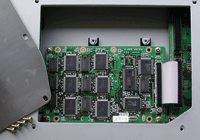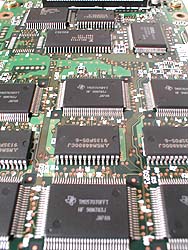![]()
![]()
|

The EXB-Moss expansion is a 6 Voices polyphony and Multi-timbral DSP Synthesizer Board. It's based on the physical modeling technology developped by Sondius-XG (Standford University, visit : http://www.sondius-xg.com/). The new synthesis modes available on this board are the following : Standard, Ring Modulation, Cross Modulation, Oscillator Sync, VPM (Variable Phase Modulation), Comb filter oscillator, Resonance oscillator, Organ model, Electric piano model, Brass model, Reed model, Plucked string model, and Bowed string model
Korg's mission to bring musicians the benefits of physical modelling synthesis at an affordable price continues; The MOSS Modeling Board, is comparable to its predecessor called the Z1...
When Korg demonstrated the Z1 prototype at its launch in the Lloyds Building , presenter Paul Wiffen claimed that the new synth was born in the company's 'More' department... the one that satisfies the dealers' and customers' incessant demands for more of this, more of that and, most probably, more of the other too. This must be one of Korg's busiest divisions, because over the past nine years it has added more voices, more effects and more sequencing capabilities to every PCM-based workstation since the M1. Similarly, it has expanded the Wavestation from its earliest incarnations through the EX, the AD, and finally the SR. Now the department has evidently got its hands on Korg's first physical modelling synthesizer, the Prophecy, and this has suffered more than most... The result is more voices, more physical models, and more performance options.
BASICS
The MOSS Board, in its basic configuration, 6-voice polyphonic, with each voice derived from a pair of physically modelled oscillators plus a sub-oscillator and a noise source. Voices can be spread multitimbrally across six MIDI channels, making the MOSS Board one of the world's first multitimbral physical modelling synthesizer. Furthermore, you can derive each part from a different model and map it to a different zone on the keyboard. Fortunately, Korg haven't limited their new baby to the "slavish imitation of analogue": the MOSS Board offers more than double the number of models found in the Prophecy. There are now 13 of these, each derived from the much-touted but as yet unheard OASYS (Open Architecture SYnthesis System). Korg have never made this $10,000 mega-synth available to the public, and it now looks more like a development platform for the company's affordable instruments than a product in its own right.
MODELS & EFFECTS
The MOSS Board retains all the Prophecy's physical models, including, of course, its analogue model. Based upon two DSP-generated oscillators, two resonant filters, and two envelope generators per voice, the model echoes many classic monosynths of the 1970s. But, whereas the Prophecy was monophonic and was, therefore, comparable to a Minimoog or Korg 700S, the MOSS Board 's polyphony makes it more like a Prophet or Oberheim Matrix . The MOSS board even offers a Unison mode that allows you to assign two, three or six detuned voices to each note. Since the MOSS Board remains multitimbral in this mode, even the most revered analogue synths of yesteryear may soon find their over-inflated reputations and excessive values threatened. Similarly, the Moss Board incorporates an organ model that steps beyond conventional Sample + Synthesis methods. This allows you progressively to introduce or remove virtual tonewheel generators, just like pulling and pushing the drawbars of a genuine Hammond. There are limitations, but my first impression was one of 'grit' and considerable authenticity. This may, of course, be a consequence of Korg's Leslie effect algorithms (as found in the G4 and Trinity), so we'll have to investigate further. The Moss board offers a Frequency Modulation model (Korg named their last FM implementation 'VPM' -- Variable Phase Modulation -- for legal reasons.) Anyway, the FM model generates many of the bell-like, percussive and piano-type sounds that made the Yamaha DX7 such a world-wide success. I find the use of DSPs to recreate earlier digital synthesizers peculiarly amusing, but it proves that the idea of a 'classic' synth is a flexible one, not limited to analogue instruments such as Moogs, ARPs and the Jupiter 8. Whether the concept is arcane or not, I'm looking forward to using this model more extensively. The DX7 suffered from appalling hiss, and the idea of noise-free versions of its best sounds appeals greatly to me. Finally, there's a bowed string model that complements its plucked counterpart. You can use this for orchestral strings or together with the analogue model for some luscious pads.
Once you have selected and programmed your models, you can pass the result through the Triton Studio 's effects processors. This arrangement allows you, for example, to flange your guitar sounds while chorusing your pianos and independently EQ-ing your bass, brass, and strings.

